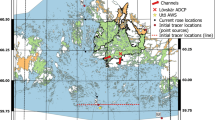Abstract
The water below a depth of 1,000 m in the Japan Sea was found to consist of two water masses, the upper layer (the Deep Water) and the lower layer (the Bottom Water). The boundary of these water masses is marked by discontinuity of potential temperature, dissolved oxygen and silicate at about 2,000 m depth. The mean residence time of the Bottom Water was calculated to be 300 years from analysis of carbon-14 data using a box model. By applying a one dimensional diffusion advection model to the profiles of potential temperature and dissolved oxygen, it was suggested that the upward advection in the Deep Water occurs most intensively in the basin south of the Yamato Rise. The Bottom Water seems to be formed not in the northernmost region of the Japan Sea but in the northwestern area, judging from the distributions of potential temperature and dissolved oxygen.
Similar content being viewed by others
References
Broecker, W.S. (1974): Chemical Oceanography. Harcourt Brace Jovanovich, Inc., 214 pp.
Broecker, W.S. and T.-H. Li (1970): Interchange of water between the major oceans. J. Geophys. Res.,75, 3545–3552.
Broecker, W.S. and T.-H. Peng (1982): Tracers in the Sea. A publication of the Lamont-Doherty Geological Observatory, Columbia Univ., Palisades, New York, 690 pp.
Chung, Y. (1975): Areal extent of the benthic front and variation of the scale height in Pacific deep and bottom waters. J. Geophys. Res.,80, 4169–4178.
Chung, Y. and H. Craig (1973): Radium-226 in the eastern equatorial Pacific. Earth Planet. Sci. Lett.,17, 306–318.
Craig, H. (1969): Abyssal carbon and radiocarbon in the Pacific. J. Geophys. Res.,74, 5491–5506.
Craig, H. and R.F. Weiss (1970): The GEOSECS 1969 intercalibration station: introduction, hydrographic features, and total CO2-O2 relationships. J. Geophys. Res.,75, 7641–7647.
Druffel, E.M. (1980): Radiocarbon in annual coral rings of Belize and Florida. Radiocarbon,22, 363–371.
Fofonoff, N.P. (1962). Physical properties of seawater. In: The Sea, Vol. 1. ed. by M.N. Hill, Interscience Publ., p. 3–30.
Gamo, T. and Y. Horibe (1980): Precise determination of dissolved gases in sea water by ship-board gas chromatography. Bull. Chem. Soc. Japan.,53, 2839–2842.
Horibe, Y. (1981): Preliminary Report of the Hakuho Maru Cruise KH77-3 (Pegasus Expedition). Ocean Research Institute, Univ. of Tokyo, 55 pp.
Horibe, Y. and T. Gamo (1981): Modified Carpenter's method. In: Preliminary Report of the Hakuho Maru Cruise KH77-3 (Pegasus Expedition), ed. by Y. Horibe, Ocean Research Institute, Univ. of Tokyo, p. 53–55.
Horibe, Y., Y. Kodama, and K. Shigehara (1972): Errors in sampling procedure for the determination of dissclved oxygen by Winkler method. J. Oceanogr. Soc. Japan.,28, 203–206.
Japan Maritime Safety Agency (1966): Bathymetric chart of the adjacent seas of Nippon, sheet 1 (No. 6301). Tokyo.
Kobayashi, H., T. Hirose, M. Sugino, and N. Watanabe (1974): University of Tokyo radiocarbon measurements V. Radiocarbon,16, 381–387.
Moriyasu, S. (1972): The Tsushima Current. In: Kuroshio: Its Physical Aspects, ed. by H. Stommel and K. Yoshida, Univ. of Tokyo Press, p. 353–369.
Nagaya, Y. and K. Nakamura (1981): Artificial radionuclides in the Western Northwest Pacific (I)90Sr and137Cs in the deep waters. J. Oceanogr. Soc. Japan,37, 135–144.
Nitani, H. (1972): On the deep and bottom waters in the Japan Sea. In: Research in Hydrography and Oceanography, ed. by D. Shoji, Hydrographic Department of Japan, p. 151–201.
Östlund, H.G., H.G. Dorsey, and C.G. Rooth (1974): GEOSECS North Atlantic radiocarbon and tritium results. Earth Planet. Sci. Lett.,23, 69–86.
Stuiver, M. and H.G. Östlund (1980): GEOSECS Atlantic radiocarbon. Radiocarbon.22, 1–24.
Stuiver, M. and H.A. Polach (1977): Discussion: reporting of C-14 data. Radiocarbon,19, 355–363.
Suda, K. (1932): On the bottom water in the Japan Sea (preliminary report). J. Oceanogr.4, 221–241 (in Japanese).
Sverdrup, H.U., M.W. Johnson, and R.H. Fleming (1942): The Oceans: Their Physics, Chemistry, and General Biology. Prentice-Hall, Inc. Englewood Cliffs, New Jersey, 1087 pp.
Weiss, R.F. (1970): The solubility of nitrogen, oxygen and argon in water and seawater. Deep-Sea Res.,17, 721–735.
Wolberg, J.R. (1967): Prediction Analysis. D. Van Nostrand, Princeton, New Jersey, 291 pp.
Author information
Authors and Affiliations
Rights and permissions
About this article
Cite this article
Gamo, T., Horibe, Y. Abyssal circulation in the Japan Sea. Journal of the Oceanographical Society of Japan 39, 220–230 (1983). https://doi.org/10.1007/BF02070392
Received:
Revised:
Accepted:
Issue Date:
DOI: https://doi.org/10.1007/BF02070392




